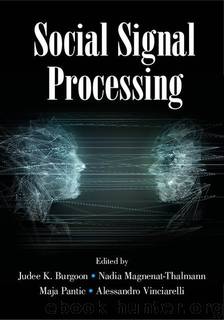Social Signal Processing by Judee K. Burgoon & Nadia Magnenat-Thalmann & Maja Pantic & Alessandro Vinciarelli

Author:Judee K. Burgoon & Nadia Magnenat-Thalmann & Maja Pantic & Alessandro Vinciarelli
Language: eng
Format: azw3
Publisher: Cambridge University Press
Published: 2017-05-18T04:00:00+00:00
16
Automatic Analysis of Social Emotions
Hatice Gunes and Björn Schuller
Automatic emotion recognition has widely focused on analysing and inferring the expressions of six basic emotions – happiness, sadness, fear, anger, surprise, and disgust. Little attention has been paid to social emotions such as kindness, unfriendliness, jealousy, guilt, arrogance, shame, and understanding the consequent social behaviour. Social context plays an important factor on labeling and recognizing social emotions, which are difficult to recognise out of context.
Social emotions are emotions that have a social component such as rage arising from a perceived offense (Gratch, Mao, & Marsella, 2006), or embarrassment deflecting undue attention from someone else (Keltner & Buswell, 1997). Such emotions are crucial for what we call social intelligence and they appear to arise from social explanations involving judgments of causality as well as intention and free will (Shaver, 1985).
To date, most of the automatic affect analysers in the literature have performed one-sided analysis by looking only at one party irrespective of the other party with which they interact (Gunes & Schuller, 2013). This assumption is unrealistic for automatic analysis of social emotions due to the inherent social aspect and bias that affect the expressiveness of the emotions in a social context or group setting. Therefore, the recent interest in analysing and understanding group expressions (e.g., Dhall & Goecke, 2012) will potentially contribute to the progress in automatic analysis of social emotions.
Recent developments in social media and social websites have opened up new avenues for the employment of user-driven and user-generated emotional and affective tone such as amused, touched, and empathy in social interactions. Accordingly, a number of researchers refer to automatic analysis of social emotions as ‘social affective analysis’ (e.g., social affective text mining) (Bao et al., 2012). Such works have focused on automatic prediction of social emotions from text content by attempting to establish a connection between affective terms and social emotions (Bao et al., 2012).
As technology is widely becoming part of our social lives, analysing and understanding human social emotions and making inference about human socio-emotional states opens up new avenues in the affective computing field with various applications, most notably for inducing behavioural change, assisting the decision-making process, and enhancing well-being to enable humans cope with emotionally-charged social situations (e.g., customized fitness and psychotherapy applications, stress management in high-stress social settings, tutoring systems, etc.) (Gratch et al., 2006). In this chapter we will provide a brief and non-exhaustive review of social emotion research focusing on automatic recognition and a summary of representative works introduced in recent years on automatic analysis of social emotions from visual and audio cues.
Download
This site does not store any files on its server. We only index and link to content provided by other sites. Please contact the content providers to delete copyright contents if any and email us, we'll remove relevant links or contents immediately.
| Automotive | Engineering |
| Transportation |
Whiskies Galore by Ian Buxton(41525)
Introduction to Aircraft Design (Cambridge Aerospace Series) by John P. Fielding(32885)
Small Unmanned Fixed-wing Aircraft Design by Andrew J. Keane Andras Sobester James P. Scanlan & András Sóbester & James P. Scanlan(32570)
Craft Beer for the Homebrewer by Michael Agnew(17930)
Turbulence by E. J. Noyes(7695)
The Complete Stick Figure Physics Tutorials by Allen Sarah(7135)
Kaplan MCAT General Chemistry Review by Kaplan(6591)
The Thirst by Nesbo Jo(6432)
Bad Blood by John Carreyrou(6271)
Modelling of Convective Heat and Mass Transfer in Rotating Flows by Igor V. Shevchuk(6219)
Learning SQL by Alan Beaulieu(6031)
Weapons of Math Destruction by Cathy O'Neil(5825)
Man-made Catastrophes and Risk Information Concealment by Dmitry Chernov & Didier Sornette(5644)
Digital Minimalism by Cal Newport;(5388)
Life 3.0: Being Human in the Age of Artificial Intelligence by Tegmark Max(5182)
iGen by Jean M. Twenge(5158)
Secrets of Antigravity Propulsion: Tesla, UFOs, and Classified Aerospace Technology by Ph.D. Paul A. Laviolette(4984)
Design of Trajectory Optimization Approach for Space Maneuver Vehicle Skip Entry Problems by Runqi Chai & Al Savvaris & Antonios Tsourdos & Senchun Chai(4837)
Electronic Devices & Circuits by Jacob Millman & Christos C. Halkias(4743)
